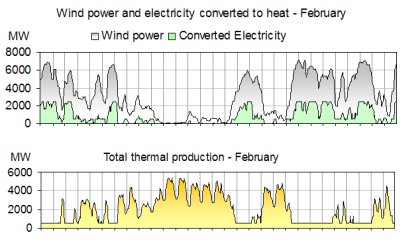There is a quite polarized debate on wind power, particularly abroad. Keen supporters of wind power play down the need for special measures. They claim that all problems will be dissolved in the large European market.
This is pure ostrich policy. Maintaining high security of supply, cogeneration of electricity and heat and efficient utilisation of wind power at the same time will require new local measures to be developed in due time.
The Danish transmission system operator, Energinet.dk, has made a large effort for analysing and describing the possibilities for integration of wind power, see Energinet.dk.
Smart Grid is birds in the bush
Experts in many countries have worked eagerly to solve the integration problems of wind power. New power system architecture has been introduced as a "Smart Grid" which is supposed to offer users of the power system new innovative services and mobilise flexibility which was so far unexploited.
Electrical vehicles combined with other advanced technologies are supposed to provide essential contributions. This is a possibility, but not until the "smart grid" services are ready for practical use in Denmark. It may take several years before smart grids can provide any appreciable flexibility.
It has been claimed that utilising overflow electricity is no problem because it can be stored in Norway. This solution should be chosen when it is profitable, but congestion or economy may suggest other solutions. The Norwegian service has a cost and the price depends on the Danish alternatives. Therefore domestic alternatives can be of great value.
CHP systems can utilize electricity overflow
I am particularly interested in Denmark's opportunity to create cheap and efficient domestic alternatives by coordination with the district heating systems. Hot water for heat supply for many hours is stored in pipes and tanks in the district heating systems. The hot water is a significant storage allowing a very flexible operation of the power plants.

If this flexibility remains unexploited wind power and CHP plants will compete for insufficient electricity consumption. In addition we make an effort to save electricity. The result can be overflow of electricity, reduced cogeneration and more heat production on backup boilers.
Optimal utilisation of hot water storages can together with electric heating of water for district heating eliminate about half of the problems created by increasing wind energy penetration from 10% to 50% of the electricity consumption.
The Analysis has been published in "EuroHeat & Power" in 2011.
More advanced analyses will be needed. In Germany the peak capacity of photovolaic (PV) has now reached the same level as the wind power cpacity. This could also become the case in Denmark.
On the other hand new concepts with seasonal storages and heat pumps are being commissioned in Denmark. Results from these new plants will be presented at this web site when available.
See the notes below.